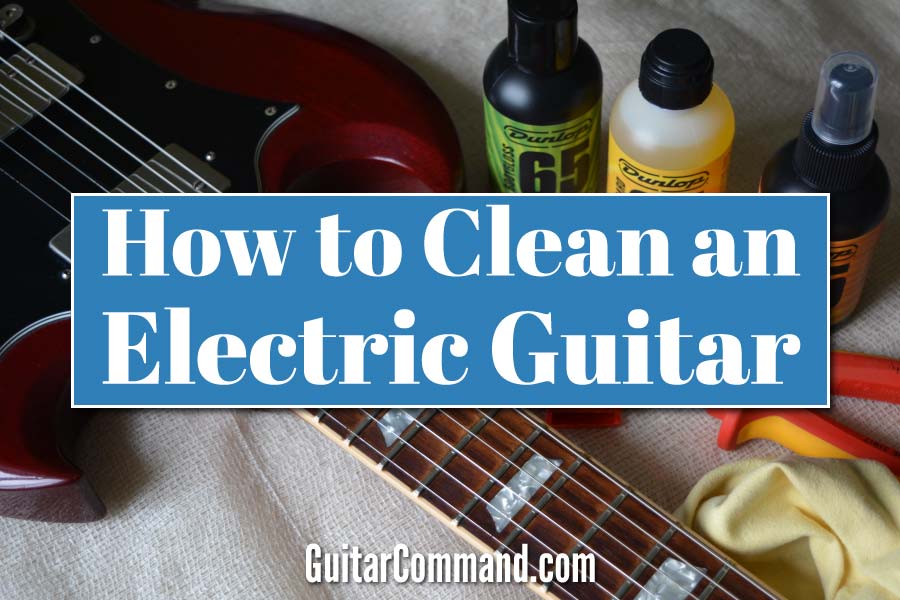On this page you’ll find out how to clean an electric guitar.
Follow along with our step-by-step guide to cleaning an electric guitar, and watch as we give a neglected Gibson SG a much-needed spring clean!

How To Clean An Electric Guitar: Page Index
- Electric Guitar Cleaning Products
- Things You Need To Clean An Electric Guitar
- How To Clean An Electric Guitar: Step-By-Step Guide
- How To Keep Your Guitar In Good Condition
- How Often Should You Clean An Electric Guitar?
Although it’s not something you have to do every day, it’s a good idea to give your guitar a thorough clean at least once or twice a year.
A neglected guitar is more likely to pick up scratches and knocks than one that's regularly cleaned (you, and people living with you, will be less likely to treat it with care if it looks like s**t). In addition, the longer dirt is allowed to accumulate on an electric guitar, the harder it is to remove.
The basic steps to cleaning an electric guitar are shown below. Click on each step for more details, or continue reading for a complete guide to cleaning an electric guitar.
- Prepare your work surface
- Remove the strings from your guitar
- Perform a visual check and remove dust / loose dirt
- Clean the fretboard
- Clean the body
- Re-string the guitar
- Keep your guitar in good condition
Electric Guitar Cleaning Products
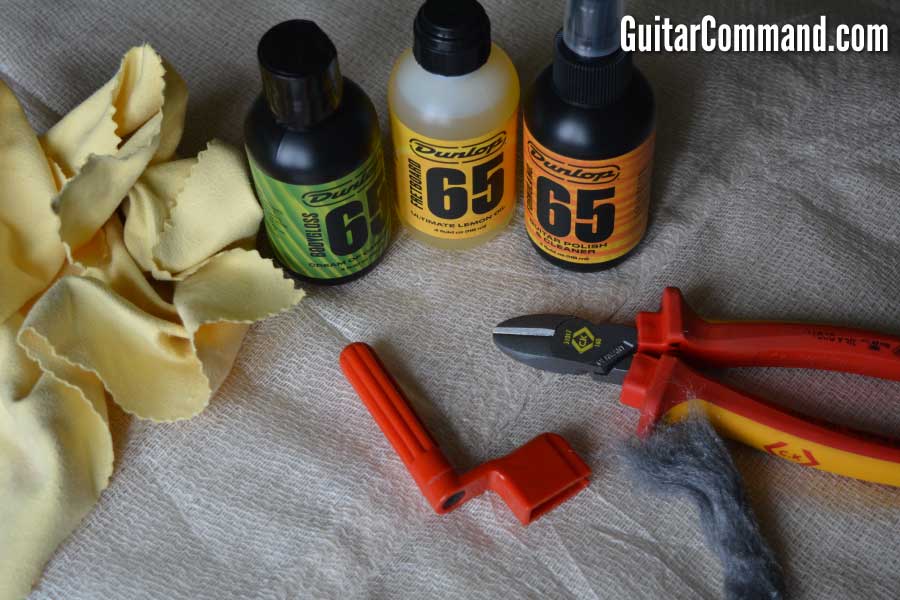
The links on this page are Amazon affiliate links; if you make a purchase after clicking on a link, we'll receive a small royalty. As you can see from the pictures, we used all of the cleaning products mentioned.
As you can probably imagine, there are a large number of specialized electric guitar cleaning products available.
Before you rush to your local guitar shop however, know that you don’t need to buy every single bottle of expensive guitar cleaner.
In fact, just a damp cotton cloth can go a long way in cleaning both the fretboard and the body of your guitar.
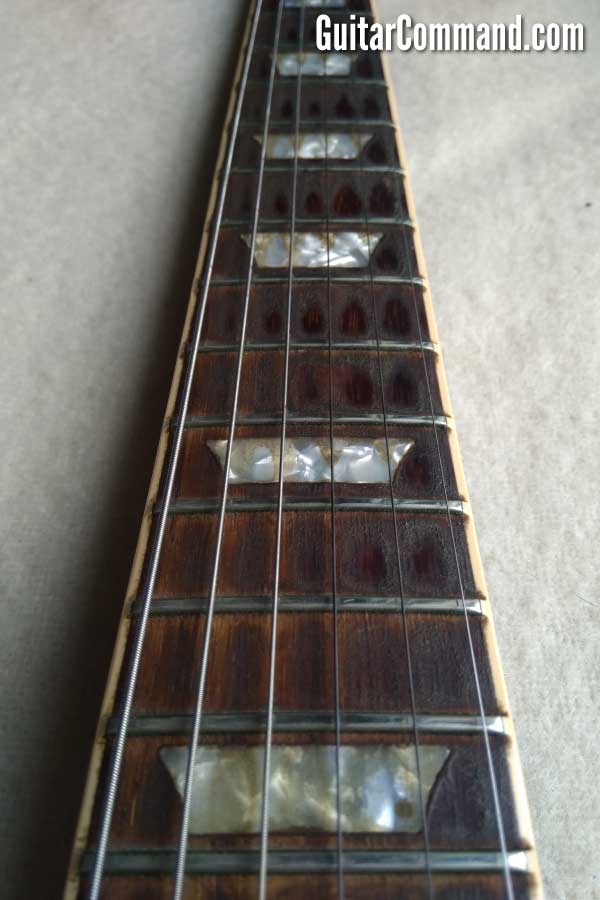
If you do want to get some specialised cleaning products, then you probably won’t need much more than some guitar polish for the body and some lemon oil to condition the fretboard.
In the step-by-step guitar cleaning guide below, we used the following cleaning products:
- Dunlop Formula 65 Guitar Polish & Cleaner
- Dunlop Formula 65 Cream of Carnauba Wax Polish
- Dunlop Formula 65 Lemon Oil
(We used the Dunlop Guitar Polish Kit, which contains both the polish and wax shown above, together with a cleaning cloth.)
- Formula 65 Guitar Polish Kit
- Country of Origin: United States
- Package Weight: 0.71 pounds
- The Formula 65 Guitar Polish Kit contains the best-seller Formula 65 Guitar Polish & Cleaner and Body Gloss Cream of Carnauba Wax
What Do You Need To Clean An Electric Guitar?
For removing old strings and installing a new set:
- String winder (to help remove and install strings)
- Wire cutter (to remove strings and clip ends of new strings)
D'Addario make a useful all-in-one string winder and cutter tool that will do both jobs:
- ALL-IN-ONE GUITAR STRING WINDER TOOL - The ergonomic and high-quality design of the D'Addario Accessories Pro-Winder makes string changes quicker and easier than ever before with its built-in clippers, bridge pin puller and peg winder all rolled into one tool.
- MUST HAVE FOR EVERY GUITAR CASE – Why fill up your case with three tools when you can have one that does it all? This indispensable tool has been designed to fit comfortably in your hand and for use on virtually all electric and acoustic guitars, basses, banjos and mandolins. Also available in a bass guitar version.
- GUITAR WINDER - The guitar peg winder fits onto the guitar tuning peg and rotates to help wind the guitar strings making a quicker string change for your guitar.
- BUILT IN STRING CUTTER – With the hardened steel clippers on the Pro-Winder String Cutter you can cleanly cut through your old strings to remove them quicker and easier, and trim the excess off new strings after looping them through the tuning machines.
- INTEGRATED GUITAR PIN REMOVER - Designed with acoustic guitarists in mind, the Pro-Winder has a built-in bridge pin puller. This makes removing stubborn pins simple without risking damage caused by pliers and other tools.
For cleaning the guitar:
- Soft cotton cloth (preferably two)
- Paintbrush with long, soft bristles for cleaning nooks and crannies
- Lemon oil
- Guitar polish
- Old credit card, or similar soft plastic card.
- Guitar wax (optional, but gives a deeper shine than standard polish)
- 0000-guage wire wool (optional, and should be used with care; don’t even think about getting it near a guitar’s body or finished fretboard.)
The basics
- A sturdy work surface covered with an old blanket or two
- Good natural light
- At least a couple of hours
How To Clean An Electric Guitar: A Step-By-Step Guide
1. Prepare your work surface
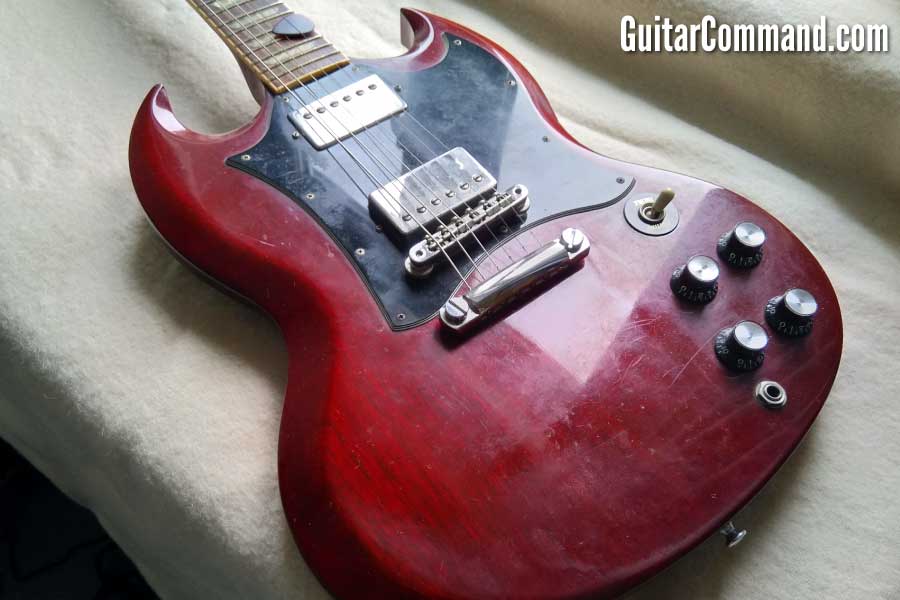
Firstly, decide where you’re going to clean your guitar. It should be somewhere well-lit, ideally with natural light (it’s much easier to inspect your guitar under natural light).
It’s all too easy to damage your guitar while it’s being worked on, so take precautions against accidental damage before you start.
Unless you have a workbench specifically for the purpose, we suggest lying an old blanket (or two) over a desk, and pulling the desk away from the wall, thereby giving you access from all angles.
If you’ve got a Gibson or other guitar with an angled headstock, then it’s a good idea to have some kind of support for the neck as you’re cleaning it – you don’t want to be pushing down on a guitar that’s being supported on a known weak point.
Commercially-produced products such as a guitar maintenance mat and a guitar neck support are available (see below), but we don’t think they’re really necessary.
- Safe and sturdy system for repair and maintenance on your guitar, bass, banjo, mandolin, ukulele, violin, and other stringed instruments
- Neck support has two angles and heights for any instrument
- Large size 47-inch x 17-inch (104 X 44CM)work mat features high-performance, textured, anti-slip surface to improve traction
- Thick 0.24 inch (6 mm) TPE mat material is safe on all instrument finishes and contains no rubber, PVC, lead, latex, dioxins, or chloride
2. Remove the strings
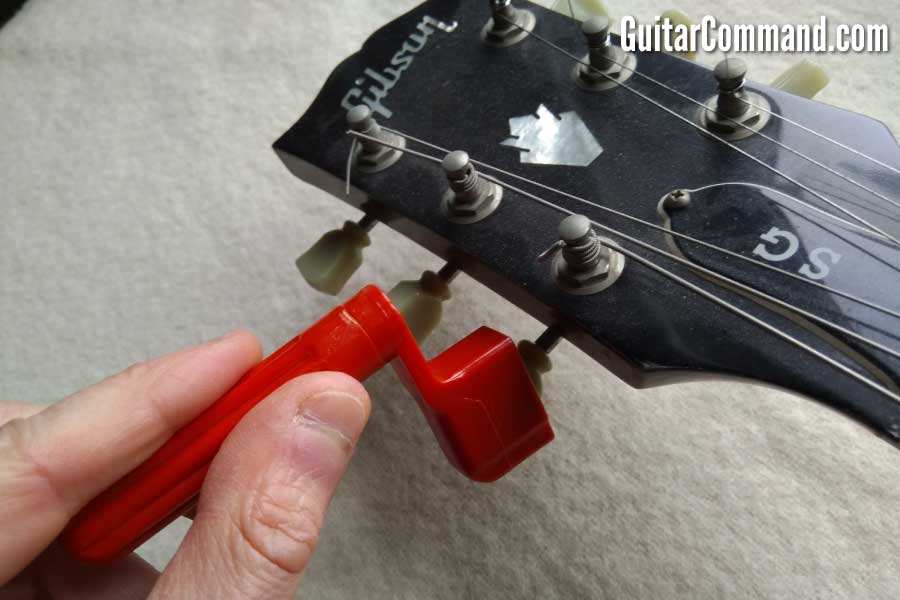
The first job in cleaning an electric guitar is removing all of the strings.
In order to remove the strings, loosen them with your string winder tool until they’re completely slack, then, using your wire cutters, cut one string at a time. The strings can then be removed from the tuning posts and bridge and disposed of.
Some people don’t like to remove all of the strings at the same time, believing that it puts undue strain on the neck.
That’s okay when you’re changing strings; you can remove and replace one or two strings at a time.
Unfortunately, it’s difficult to clean a guitar without first removing all of the strings, so unless you want to make your life a whole lot harder, it’s just something that has to be done.
For the record, we don’t believe that removing all of a guitar’s strings has any adverse effect on an instrument (at the same time we respectfully remind all those reading this page that all of the cleaning operations on this page are performed at your own risk!).
(This article is about how to clean a guitar so we won’t go into too much detail about removing and replacing strings. There are plenty of excellent YouTube videos on changing guitar strings, so refer to one of those if you are unsure about the procedure.)
- A tool such as the D'Addario string winder and cutter will make your life easier at this stage (click link to view at Amazon).
3. Get rid of dust

With the strings removed, your first task is to get rid of any loose dust and debris that has accumulated on the guitar. Use a soft cloth to go over the body and neck, and a soft-bristled paintbrush for the nooks and crannies.
Warning – be very careful using any tools near your guitar! Even a paintbrush (especially the metal part that holds the bristles in) can scratch a guitar!
You can now perform a quick visual check over the entire instrument, taking note of any areas that need particular attention.
4. Clean the fretboard
The guitar fretboard is the most likely place to pick up dirt as it’s in continuous contact with your fingers, often in hot, sweaty conditions.
There are many products available for cleaning a guitar fretboard, but in most circumstances you probably won’t need them.
At first, try to shift fretboard grime using nothing more than applying a hot breath and rubbing with a cloth. For more resilient dirt, try using saliva on the cloth (it sounds gross, but it’s highly effective).
If the dirt is refusing to shift then use a cloth that has been slightly dampened with (ideally warm) water.
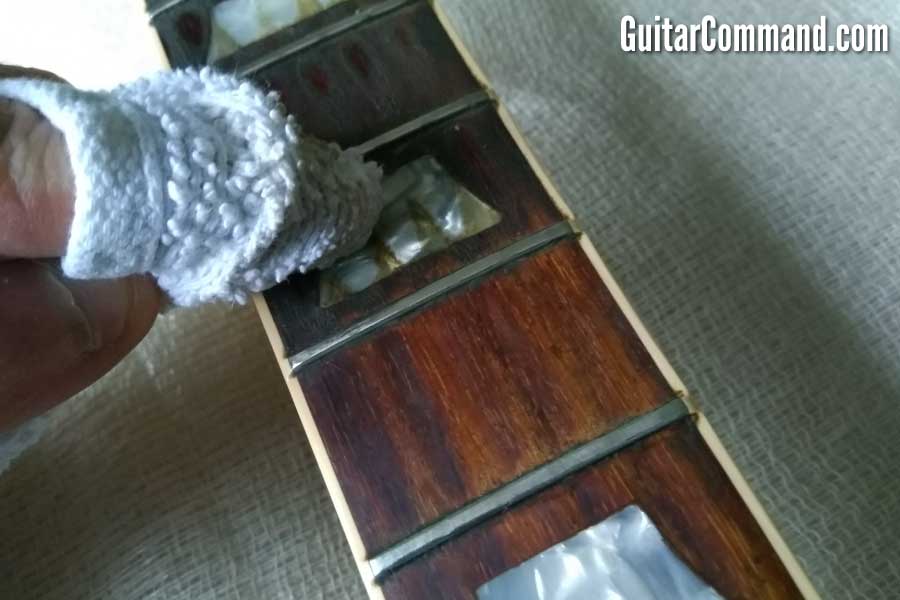
Note for owners of guitars with finished and / or maple fretboards
If your guitar’s fretboard is finished (e.g. lacquered) then don’t go any further; you’ll damage the finish of your fretboard if you use wire wool or cleaning products.
Further Cleaning For Rosewood, Ebony Or Pau Ferro Fretboards
Only if cleaning with a cloth slightly dampened with warm water proves ineffectual should you resort to cleaners / steel wool – and then only if your guitar has an unfinished (e.g. non-lacquered) rosewood, ebony or pau ferro fretboard (e.g. most black / dark fretboards).
Credit Card
One way of dislodging stubborn grime from your fretboard is by scraping it with a soft plastic card. Use extreme caution using this method; even rosewood and ebony fretboards can easily be marked if you press too hard. Soften the grime up with a damp cloth before scraping.
Steel Wool
Another way of removing fretboard dirt is by cleaning with extra-fine gauge (0000) steel wool. Again, use caution when using this method and, to repeat, do not use steel wool on a finished fretboard.
If you use steel wool to clean your fretboard, be sure to cover your pickups with masking tape to prevent metal fragments from the wool becoming attached.
Where possible, rub steel wool in the direction of the wood grain.
Lighter Fluid
Naptha / lighter fluid can be used (in extreme moderation) to remove fretboard dirt that isn’t shifting using other methods
Lemon Oil

Lemon oil (such as Dunlop Lemon Oil) is often used to clean and to moisturize the fretboard after cleaning. Apply it sparsely over the entire fretboard (most bottles come with an applicator), then rub off with a cloth.
5. Clean the body
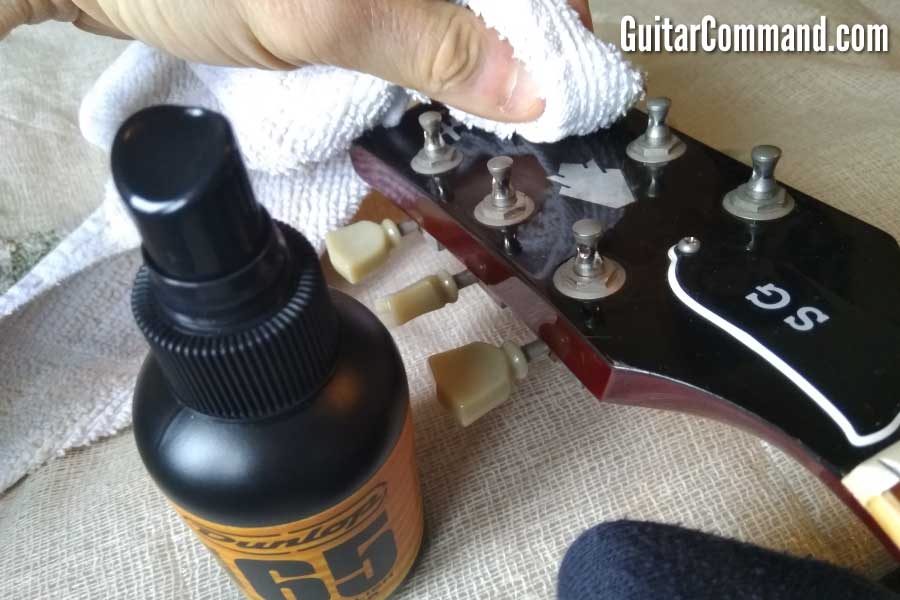
If your guitar has a natural, matte or satin finish then clean its body using a soft, dry cloth. Anything else (even a dampened cloth) is likely to worsen or damage the finish of your guitar.
For most modern guitars with glossy finishes, you should start simple, cleaning the body using hot breath / soft cloth, or a cloth ever so-slightly dampened with warm water.
Take care to stay away from the hardware when using water – you don’t want to damage electronics or cause corrosion to metal parts.
Guitar Polish
When cleaning the body of your guitar, you can use a polish such as the Dunlop Guitar Polish & Cleaner. Use a couple of sprays on a soft cloth, and apply in a circular motion. This will both clean your guitar and give it a nice shine.
Wax Polish

For a longer-lasting, showroom finish, you can use a specialist wax cleaner, such as the Dunlop Cream Of Carnuba that we used to clean our SG. This will fill in any small cracks in the finish of your guitar and result in a deeper shine than standard polish.
Apply a pea-sized blob onto a soft cloth and rub into the finish of your guitar using a circular motion. After 30 seconds, buff the area with another cloth / the reverse side of your cloth, bringing the area up to a deep shine. Very satisfying!
6. Re-string the guitar

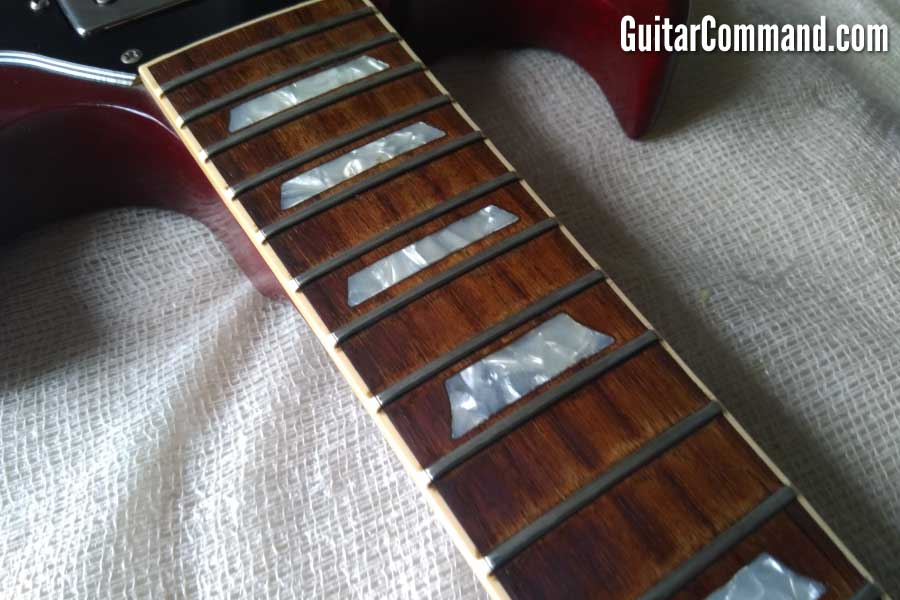
Hopefully you’ve brought your guitar to a satisfying shine and your fretboard is clear of any ugly dirt build up.
All that remains to do now is to install a brand new set of strings. This will ensure that your guitar sounds as sparkly as it looks!
How to keep your guitar in good condition
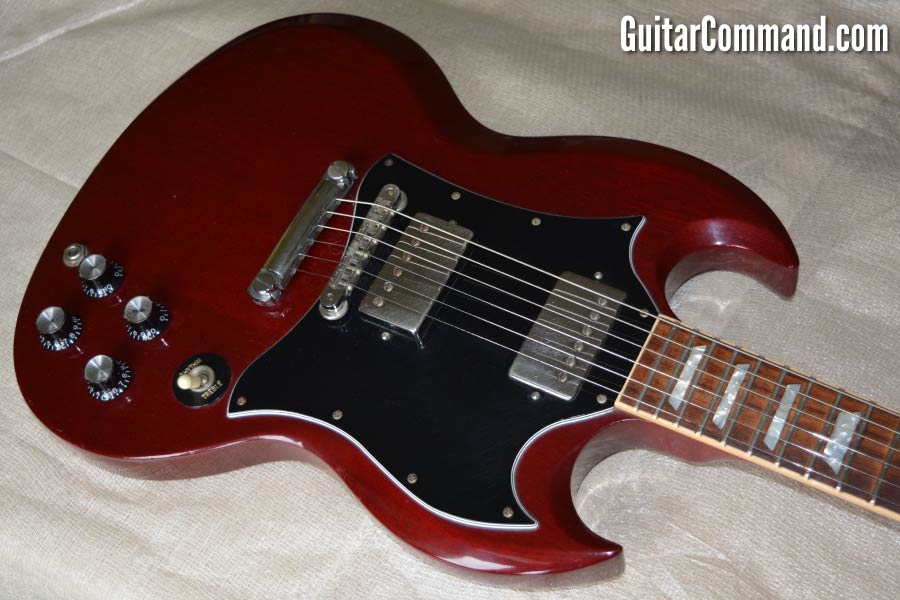
Below are some basic tips that you should follow in order to keep your guitar in good condition:
Always wash your hands before playing the guitar
Always wipe down your strings with a cloth after playing the guitar. It’s a good idea to keep a cloth in your guitar case specifically for this task.
You can maintain the finish of your guitar without doing a full clean using a polish such as Dunlop’s Guitar Polish and Cleaner on the main parts of the body.
Always store your guitar in a hard case when it’s not in use. You may – like us – find this a bit of a hassle (and a spontaneity-dampener) but it will prevent your guitar from getting dusty and from picking up knocks.
If you don’t want to return your guitar to its case every time you finish playing it, then make sure you have either a heavy-duty guitar stand or a good-quality wall-hanger to keep your instrument out of harm's way.
How Often Should You Clean An Electric Guitar?
Cleaning an electric guitar is a time-consuming process and how often you do it is largely up to you.
Provided you regularly dust your guitar’s body and wipe down the fretboard after use, then you may only need to give it a full clean once or twice a year, especially if you polish the body too every month or so.
If you like keeping your guitar in showroom condition, then you may want to give it a thorough clean every month.
Products We Used To Clean Our Guitar
- Dunlop Formula 65 Guitar Polish & Cleaner
- Dunlop Formula 65 Cream of Carnauba Wax Polish
- Dunlop Formula 65 Lemon Oil
(We used the Dunlop Guitar Polish Kit, which contains both the polish and wax shown above, together with a cleaning cloth.)
- Formula 65 Guitar Polish Kit
- Country of Origin: United States
- Package Weight: 0.71 pounds
- The Formula 65 Guitar Polish Kit contains the best-seller Formula 65 Guitar Polish & Cleaner and Body Gloss Cream of Carnauba Wax

